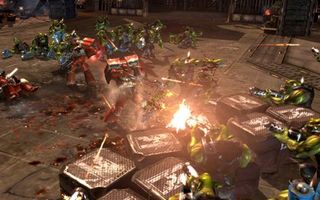Warhammer 40,000: Dawn of War 2
A new transmission from the heart of Relic's grandiose galactic conflict
“Our mantra is that things can only go in if they’re f---ing amazing,” says Relic’s Jonny Ebbert, the lead designer for Dawn of War 2. “It has to have massive visual impact.” Behind him loom giant images from Games Workshop’s overwrought military-gothic science fiction, and on the presentation screen an image of explosive bloodletting from the original Dawn of War. That game is four years old and still the most visceral strategy title available. It’s clear that “massive visual impact” isn’t something Ebbert’s team is going to have too much trouble with.
Lead designer Ebbert and his producer Mark Noseworthy flank a giant projector screen in Relic’s boardroom. They’re explaining how Dawn of War sets up the nature of its sequel. All that was best about that game, such as its vicious melee combat and feeling of solidity, is providing cues for the new direction this game moves in. This time, the focus is going to be on the actions of a small team of personalised soldiers. It’s about “five or six squads of elite warriors” whose actions are going to define the course of galactic events in the Warhammer universe. It’s closer and more intimate than the original game, moving away from that anonymous unit production-line feel of the previous Dawn of War titles.

Dawn of War 2 has another parent, however: the mighty Company of Heroes - a game which has done more to alter our perception of real-time strategy than any other title in the past five years. Company of Heroes created a game in which the more realistic behaviour of our units made for compelling play. We saw buildings collapse, craters form, and soldiers dive for safety behind shattered scenery.
The same kind of methodology is at work here, with a highly tweaked version of the Company of Heroes Essence engine powering the proceedings. The game will consequently have a tighter, more brutal focus than the original. Relic are moving away from the templates laid out by Command & Conquer and StarCraft, to bring us something a little more exotic and at the same time a little more believable.
“The environmental strategy from Company of Heroes has been brought to Dawn of War 2,” says Noseworthy as he reels off the list of technologies that are set to beef up this new game: Havok physics, destructible scenery, HDR and real-time lighting. Just as Company of Heroes made our soldiers find cover or killed them off in collapsing structures, so Dawn of War 2 will be making orks and space marines interact with their world in a maelstrom of tumbling debris, flickering shadows and brightly burning explosions. The world of Dawn of War 2 will not, says Ebbert, simply see us fighting over "just another patch of dirt." Instead the environments themselves should give us reasons to want to conquer them. As the game camera pans over the world and we get our first glimpse of these places, we can see just how that works: moody pseudo-Roman Imperial architecture disappears into gloomy city depths, and there’s a flicker of gunfire far below. Ash and debris gust through the cast-iron avenues.
But there’s something else going on here that Relic want to talk about, and which we need to convey before we get to the action. It’s that Relic are acutely aware that the real-time strategy genre needs to bring us new experiences. It needs, in Ebbert’s words, to provide us with “superior fantasies.” He says that other games have already been doing that, and it’s down to Relic to figure out how to make that happen with the RTS.
Sign up to the GamesRadar+ Newsletter
Weekly digests, tales from the communities you love, and more
